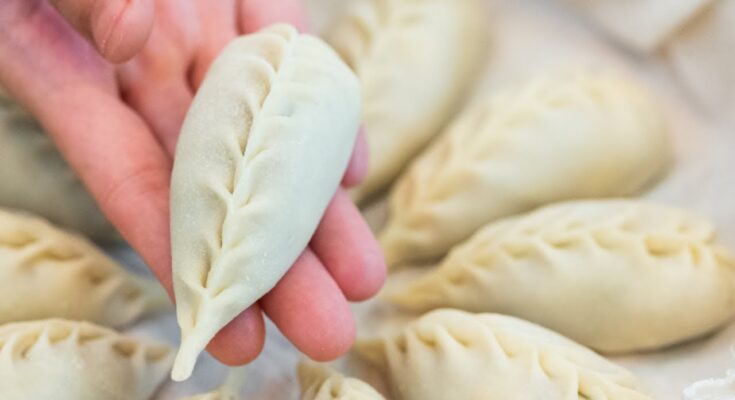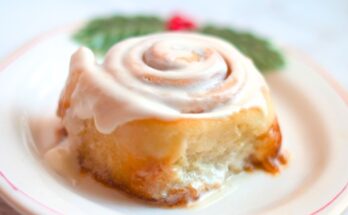Chinese Dumpling Recipe: Chinese dumplings, also known as jiaozi, are more than just food—they are a symbol of tradition, togetherness, and celebration. For centuries, they have been at the heart of family gatherings, especially during the Lunar New Year, when making dumplings together symbolizes unity and prosperity. These delightful little parcels are made with thin dough wrappers filled with flavorful meat, seafood, or vegetables, and they are enjoyed boiled, steamed, or pan-fried.
What makes dumplings special is not just their taste but their meaning. In Chinese culture, dumplings resemble ancient gold ingots, symbolizing wealth and fortune. Families gather to prepare them, chatting, laughing, and passing down techniques through generations. It’s not only about eating but about bonding.
Globally, dumplings have taken on different forms, from Japanese gyoza to Korean mandu, proving their versatility and universal appeal. Unlike many other dishes, dumplings can be completely customized—you can make them spicy, mild, meaty, or vegetarian, and they’ll always be satisfying.
They’re like little edible packages of happiness. Soft on the outside and bursting with flavor on the inside, dumplings offer comfort in every bite. Whether you are a first-timer or a seasoned cook, learning to make dumplings at home is a rewarding journey that connects you to a long culinary tradition.
Types of Chinese Dumplings
Chinese dumplings come in different varieties, and knowing them helps you decide how to prepare your own. Here are the most popular ones:
Jiaozi (Boiled Dumplings)
These are the most common dumplings in China. They are boiled in water until tender and are often served with a dipping sauce. Boiled dumplings have a soft, chewy texture and are very filling.
Guo Tie (Pan-Fried Dumplings)
Known as “potstickers,” these are fried in a pan until the bottom is golden brown, then steamed with a splash of water to cook the filling. The result is crispy on one side and soft on the other—an irresistible combination.
Shumai (Steamed Dumplings)
These are open-faced dumplings usually filled with pork and shrimp. They are steamed in bamboo baskets and served hot with soy-based sauces.
Wontons vs. Dumplings
Many people confuse wontons with dumplings. The main difference is that wontons have thinner wrappers and are often served in soup, while dumplings have slightly thicker wrappers and can be boiled, steamed, or fried.
Ingredients You’ll Need
The beauty of dumplings is that they require simple, everyday ingredients. Here’s what you’ll need:
Dumpling Wrappers
You can buy pre-made wrappers at any Asian grocery store, but if you want to go authentic, homemade wrappers are the way to go. Homemade dough is just flour and water, rolled out thin, and cut into small circles.
Protein Options
Traditionally, dumplings are made with ground pork, but you can use ground chicken, beef, shrimp, or even tofu for vegetarian dumplings. Each protein gives a slightly different flavor, but the seasoning ties everything together.
Vegetables & Aromatics
Cabbage, napa cabbage, scallions, garlic, and ginger are the most common vegetables and aromatics used. They add freshness and crunch to the filling while balancing the richness of the meat.
Sauces & Seasonings
Soy sauce, sesame oil, rice wine, salt, and white pepper are essential for flavoring the filling. They create the perfect umami balance that makes dumplings irresistible.
Optional Dipping Sauces
Dumplings taste even better with dipping sauces. A simple mixture of soy sauce, vinegar, sesame oil, and chili oil makes a fantastic companion. Some people also enjoy peanut sauce or sweet chili sauce.
Essential Tools for Making Dumplings
Making dumplings doesn’t require a fancy kitchen, but having the right tools makes the process smoother.
Rolling Pin and Dough Cutter
If you’re making wrappers from scratch, a small rolling pin is necessary. A dough cutter or round mold helps cut perfect circles.
Dumpling Steamer or Bamboo Basket
For steaming dumplings, a bamboo basket placed over a pot of boiling water is traditional. It also adds a subtle woody aroma to the dumplings.
Non-Stick Pan for Pan-Frying
For pan-fried dumplings, a good non-stick skillet is a must. It ensures the dumplings get crispy without sticking to the pan.
Mixing Bowls and Spatulas
You’ll need mixing bowls to prepare the filling and a spatula to mix everything evenly. Using your hands works too, but a spatula helps keep things neat.
Step-by-Step Guide to Making Dumplings
Step 1 – Making or Preparing Dumpling Wrappers
If you’re buying store-bought wrappers, simply keep them covered with a damp cloth to prevent drying. If making at home, mix all-purpose flour with warm water to form a dough. Knead until smooth, rest for 30 minutes, then roll into a long log. Cut into small pieces, roll each piece into a ball, and flatten into thin circles. Homemade wrappers are softer and more elastic, making them easier to fold.
Step 2 – Preparing the Filling Mixture
In a large bowl, combine your protein (like ground pork or chicken) with finely chopped cabbage, scallions, ginger, and garlic. Add soy sauce, sesame oil, rice wine, salt, and pepper. Mix well until the filling becomes sticky—this ensures it binds well inside the dumpling wrapper. Some cooks stir the filling in one direction only for a smoother texture.
Step 3 – How to Fold Dumplings
Place a wrapper in your palm, spoon a small amount of filling in the center, and fold. The classic fold is a half-moon shape with pleats along one side. You can also fold them like little purses or triangle shapes—each fold has its charm. The key is sealing tightly so the filling doesn’t leak.
Step 4 – Cooking Methods
- Boiling: Drop dumplings into boiling water. Stir gently to prevent sticking. When they float, cook for another 2 minutes before removing.
- Steaming: Place dumplings on parchment paper in a bamboo steamer and steam over boiling water for 10 minutes.
- Pan-Frying: Heat oil in a skillet, place dumplings flat-side down, fry until golden, then add water and cover to steam until cooked through.
Step 5 – Serving and Pairing with Dipping Sauces
Serve dumplings hot with dipping sauces. A classic mix is soy sauce, vinegar, sesame oil, and chili oil. Pair with hot tea or a light soup for a complete meal. Dumplings can also be frozen before cooking, making them perfect for quick meals anytime.
Tips for Perfect Dumplings
Dumplings may look simple, but small details can make or break your recipe. To achieve restaurant-quality dumplings at home, you’ll need to focus on a few tricks. First, always keep your wrappers moist. Whether you’re using store-bought or homemade wrappers, they dry out quickly, and once they do, sealing them becomes difficult. Keep them covered with a damp cloth while working.
Next, pay attention to the filling’s moisture content. Too much liquid will cause your dumplings to burst during cooking, while too little will make them dry and bland. A common trick is to squeeze out excess water from vegetables like cabbage before mixing them into the filling. This ensures the filling stays juicy but not watery.
Seasoning is another key factor. Dumplings should have a balance of salty, savory, and aromatic notes. Ginger and garlic bring warmth, sesame oil adds depth, and soy sauce provides umami. Don’t be afraid to taste-test a small portion of the filling by pan-frying it before making all your dumplings—this way, you can adjust the seasoning as needed.
Lastly, practice makes perfect when it comes to folding. Your first few dumplings might look funny, but as you go, your hands will naturally get the hang of it. Remember, the important part is sealing them tightly, even if they don’t look perfect. After all, once they’re cooked and dipped into sauce, no one will care if they’re a little uneven.
Common Mistakes to Avoid
Even skilled cooks can run into issues when making dumplings. One of the biggest mistakes is overstuffing the wrapper. While it’s tempting to load up on filling, too much causes leaks and breakage during cooking. A teaspoon or tablespoon, depending on wrapper size, is usually enough.
Another mistake is not sealing the dumplings properly. If the edges aren’t pressed firmly, they’ll open up in the water or pan. Use a little water on your fingertips to help seal the edges tightly.
Cooking mistakes are common too. Boiling dumplings too long makes them soggy, while undercooking leaves the dough raw. With pan-fried dumplings, adding too much water can make the bottoms mushy instead of crispy. The trick is balance—just the right amount of heat, water, and timing.
Some people forget to rest homemade dough. Skipping the resting step makes the wrappers tough and hard to roll out. Another common error is not removing enough moisture from veggies like cabbage, which can water down the filling.
Avoiding these mistakes comes with practice. Think of dumpling-making as an art—patience and attention to detail are key. Once you learn from these common errors, your dumplings will come out perfect every time.
Variations of Dumpling Fillings
One of the best things about dumplings is their versatility. You can stuff them with almost anything, and each variation brings a new flavor experience.
Classic Pork and Cabbage
This is the most traditional Chinese dumpling filling. Ground pork mixed with napa cabbage, scallions, and ginger makes a juicy, flavorful bite.
Chicken and Mushroom
Ground chicken paired with shiitake mushrooms creates a lighter yet rich filling. The mushrooms add an earthy depth that balances beautifully with the chicken.
Beef and Onion
Ground beef with onions and soy sauce offers a hearty, satisfying dumpling, perfect for meat lovers.
Shrimp and Chives
This variation is fresh and slightly sweet. Shrimp adds a springy texture, while Chinese chives give a mild garlic flavor.
Vegetarian Dumplings
For those who don’t eat meat, dumplings can be filled with tofu, mushrooms, carrots, spinach, and cabbage. With the right seasoning, they’re just as flavorful as the meat-based versions.
Creative Twists
Modern chefs experiment with fillings like curry chicken, kimchi pork, or even dessert-style dumplings filled with sweet red bean paste or chocolate. These twists prove that dumplings can be adapted to any taste preference.
Health Benefits of Dumplings
At first glance, dumplings may seem like comfort food, but they can also be quite healthy depending on how you make them. Steamed or boiled dumplings are lower in calories and fat compared to fried ones, making them a lighter option for those watching their diet.
The filling offers protein, fiber, and essential vitamins. For example, pork or chicken provides protein, while vegetables like cabbage and carrots add fiber, vitamin C, and antioxidants. Dumplings with shrimp are rich in lean protein and omega-3 fatty acids.
Vegetarian dumplings can be especially nutrient-packed, depending on the veggies you use. Mushrooms add antioxidants, spinach contributes iron, and tofu provides plant-based protein. The balance of protein and vegetables makes dumplings a satisfying, nutrient-rich dish.
Of course, moderation is key. Fried dumplings or those loaded with too much oil may not be as healthy. But when steamed or boiled and paired with a light dipping sauce, dumplings can easily fit into a balanced diet. They’re filling without being overly heavy, making them perfect for lunch, dinner, or even as a snack.
Serving Suggestions
Dumplings are delicious on their own, but pairing them with the right side dishes and sauces can elevate the meal.
A simple dipping sauce made of soy sauce, rice vinegar, sesame oil, and chili oil is the classic choice. You can also add minced garlic or fresh cilantro for extra flavor. Some people enjoy a touch of sugar in their dipping sauce for a sweet-savory balance.
If you’re serving dumplings as the main dish, pair them with light sides like stir-fried vegetables, fried rice, or a clear soup. Hot and sour soup or miso soup complements dumplings beautifully.
For parties or family gatherings, dumplings work well as appetizers. Serve them alongside spring rolls, buns, or noodles for a complete Asian-inspired feast.
And let’s not forget beverages—dumplings pair perfectly with hot green tea, jasmine tea, or even a cold beer. The tea cuts through the richness of the filling, while beer balances the savory flavors.
How to Store and Reheat Dumplings
One of the best things about dumplings is that you can make them in large batches and save them for later. Proper storage is key to keeping their flavor and texture intact.
Storing Fresh Dumplings
If you’ve just prepared uncooked dumplings but don’t plan to cook them immediately, arrange them on a tray lined with parchment paper. Make sure they’re not touching each other—otherwise, they’ll stick together. Place the tray in the freezer for about an hour. Once frozen, transfer them to a resealable freezer bag. This method prevents clumping and keeps them ready to cook whenever you like.
Storing Cooked Dumplings
Leftover cooked dumplings can be stored in an airtight container in the refrigerator for up to 3 days. Just make sure they’ve cooled down before sealing them to avoid condensation.
Reheating Dumplings
The best way to reheat dumplings depends on how they were cooked. Steamed or boiled dumplings can be quickly reheated by steaming again for 5 minutes. Pan-fried dumplings can be reheated in a non-stick pan with a splash of water to bring back their crispy bottoms. Microwaving is the least recommended option, as it tends to make dumplings chewy and soggy.
By freezing batches of dumplings, you’ll always have a quick homemade meal on hand. Just boil or steam straight from frozen—no need to thaw. This convenience is one reason why dumplings are a beloved staple in so many households.
Dumplings Around the World
While Chinese dumplings (jiaozi) are iconic, dumplings have variations across many cultures, showing how universal the concept of dough wrapped around filling really is.
Japanese Gyoza
These are thinner, smaller dumplings often pan-fried for a crisp finish. Gyoza usually have a garlic-forward pork filling and are served with a soy-vinegar dipping sauce.
Korean Mandu
Mandu can be steamed, boiled, or fried, similar to Chinese dumplings, but they often include glass noodles and kimchi in the filling, giving them a uniquely Korean twist.
Nepalese Momos
Popular in the Himalayan region, momos are filled with meat or vegetables and served with a spicy tomato-based chutney.
Polish Pierogi
While not Asian, pierogi are dumplings filled with potatoes, cheese, or sauerkraut, showing how dumpling-like foods exist in European traditions too.
Italian Ravioli
Ravioli are pasta dumplings, typically filled with cheese or meat and served with sauce. Though different in cooking style, they share the same principle as dumplings—little pockets of delicious filling.
This global presence proves dumplings are a universal comfort food. Each region has adapted them to local tastes and ingredients, making them endlessly diverse yet familiar.
Pairing Dumplings with Sauces
The right dipping sauce can turn a good dumpling into an unforgettable one. Traditional Chinese sauces usually balance salty, sour, and spicy flavors.
Classic Soy-Vinegar Sauce
A mix of soy sauce and Chinese black vinegar is the most common pairing. Add sesame oil for nuttiness and a dash of chili oil for heat.
Garlic and Chili Sauce
If you like spice, mix chili oil with minced garlic, soy sauce, and a hint of sugar. This sauce packs a punch and pairs especially well with pork dumplings.
Peanut or Sesame Sauce
For a creamy twist, peanut butter or sesame paste mixed with soy sauce and rice vinegar creates a rich, nutty dip that complements vegetarian dumplings beautifully.
Sweet and Sour Sauce
A lighter, slightly tangy option for kids or those who prefer less spice.
Experimenting with sauces is half the fun. Some people even dip dumplings in hot soup or pair them with mustard for an unusual but tasty twist.
Dumplings for Special Occasions
In Chinese culture, dumplings aren’t just food—they’re tradition. They play a big role in festivals and family celebrations.
Chinese New Year
Dumplings are a must-have during Lunar New Year celebrations because their ingot-like shape symbolizes wealth and prosperity. Families gather on New Year’s Eve to make and eat dumplings together, hoping for a lucky year ahead.
Winter Solstice (Dongzhi Festival)
Eating dumplings during Dongzhi keeps you warm and healthy for the winter. It’s believed to prevent frostbite because of a story about a famous doctor who gave dumpling soup to villagers.
Weddings and Birthdays
Dumplings sometimes appear in wedding banquets or birthday feasts as a symbol of happiness and good fortune.
Serving dumplings during these special occasions is about more than taste—it’s about carrying on centuries-old traditions of luck, unity, and celebration.
FAQs about Chinese Dumpling Recipe
Q1: Can I make dumplings ahead of time?
Yes! You can prepare dumplings ahead, freeze them, and cook directly from frozen whenever you need them.
Q2: Are dumplings gluten-free?
Traditional wrappers are made with wheat flour, but you can find gluten-free versions made with rice flour or tapioca starch.
Q3: Can I steam dumplings without a bamboo steamer?
Yes, you can use a metal steamer, a colander over boiling water, or even a plate inside a pot with a lid.
Q4: How do I prevent dumplings from sticking together?
Dust wrappers and trays with flour or cornstarch before placing dumplings on them. Also, avoid overcrowding when cooking.
Q5: What’s the best protein for dumplings?
Pork is the traditional choice, but chicken, beef, shrimp, and tofu all work well depending on your taste.
Conclusion
Chinese dumplings are more than just a dish; they’re an experience. From kneading dough to folding wrappers and cooking them just right, each step is part of a time-honored tradition. Whether you boil, steam, or fry them, dumplings never fail to satisfy. Their versatility means you can fill them with anything you like—meat, seafood, or vegetables—and still enjoy a comforting, flavorful meal.
They’re also a food that brings people together. Making dumplings as a group is not only fun but also a way to bond with family and friends. Whether you’re celebrating Chinese New Year, cooking for a party, or just enjoying them as a snack, dumplings fit every occasion.
So next time you crave something hearty, flavorful, and meaningful, try making dumplings from scratch. You’ll not only get a delicious meal but also connect with a culinary tradition that spans centuries and cultures.



